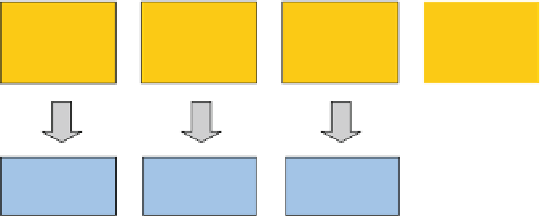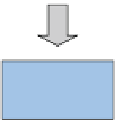Geoscience Reference
In-Depth Information
Either ..
or ..
or ..
or ..
Static model
Discrete
fracture
network
Implicit
fracture
network
Discrete
fracture
network
Implicit
fracture
network
Dynamic
model
Fracture
simulator
Dual-perm
simulator
Normal
simulator
Normal
simulator
Fig. 6.58
Alternative modelling workflows for high density fracture systems
6.7.2.2 Handling High-Density Fracture
Systems
There are numerous ways of modelling high-
density fracture systems, ranging from the very
simple to the complex. From the reservoir engi-
neering viewpoint, the focus is on whether the
fracture and matrix should both be permeable and
porous (i.e. should neighbouring grid cells connect
through the matrix, the fractures, or both). Hence,
the distinction between dual-permeability/
dual-porosity models, dual-permeability/single-
porosity, or
These packages were designed for high
density networks and were built for classic
joint-dominated naturally fractured reservoirs.
Having built them, specialist simulators are
then required to model flow through the discrete
fracture planes (Fig.
6.60
).
On the computing side, fracture modelling
algorithms are a lot less mature than standard
modelling tools. They also tend to exhibit
incompleteness, in that there is only so much
detail the current algorithms can capture explic-
itly e.g. are fractures assumed to have constant
properties? Technical guidance for correctly
upscaling multiphase fracture properties is lim-
ited, but also more practical matters such as
hardware memory limitations may limit what
can currently be achieved.
Whilst appearing to offer an ultimate solution
to the fracture modelling need, the DFN solution
is therefore not always manageable or practical,
and high levels of approximation must often be
accepted to implement this approach. Attempts at
full-field DFN models - literally modelling every
crack in the reservoir - are generally unrealistic
and at a certain level of approximation, it can be
queried whether the discrete model description is
adding much value beyond visualisation.
The most successful implementations of DFN
models are those built at the well-model scale,
and used to match well test data (e.g. Fig.
6.59
).
The outputs from this type of explicit fracture
single-permeability/single-porosity
models.
In terms of choosing a model design, another
distinction of the static and dynamic workflows
is whether the fractures are to be modelled as
explicit or implicit model properties. All
combinations are possible (Fig.
6.58
) and all are
workable.
The big issue for reservoir modellers is that
explicit methods are generally more time-
consuming, both in terms of people-time and
computer-time.
6.7.2.3 Discrete Fracture Network (DFN)
Models
Explicit fracture modelling methods are gener-
ally described as discrete fracture network
models (DFNs) and involve building digital
representations of the fracture planes (Fig.
6.59
).






